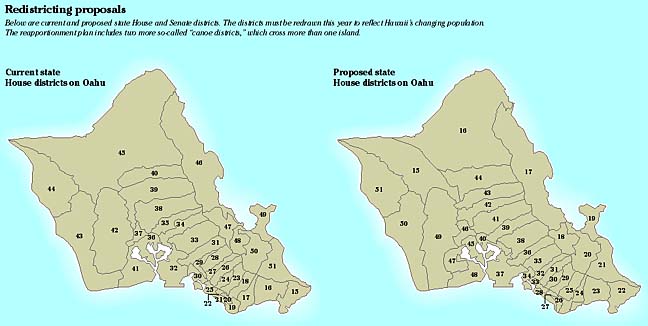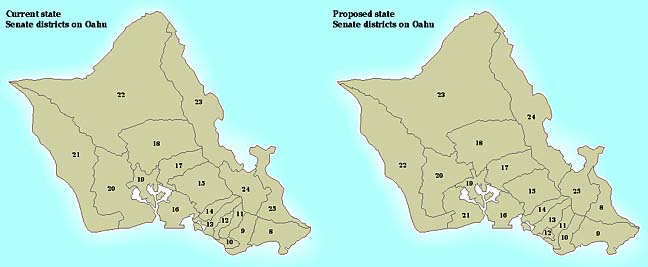

Redistricting panel Faith Evans and Pam Lee Smith have opposing views about the proposed new political districts for the state Legislature.
braces for critics
at public hearings
The addition of military dependents
and canoe districts may come under fireBy Pat Omandam
pomandam@starbulletin.comEvans, chairwoman of the Kailua Neighborhood Board, questions why the 2001 Reapportionment Commission put her middle-class, largely Republican community in the same state Senate district as Hanalei, Kauai, a small Democratic town famous for its picturesque sunsets.
"It's ridiculous," Evans said. "These are two different communities ... and I don't think either community can be served well."
But Smith, who serves on the Ewa Neighborhood Board, is elated with how the appointed bipartisan panel redrew the Ewa Plain. The commission added two new House districts and a new Senate district to account for the growth in Leeward Oahu over the past 10 years.
"I'm happy with the ways things have fallen down out here," said Smith, a Republican who lost to state Rep. Willie Espero (D, Ewa Beach) in last year's general election and is enthusiastic about running for a House seat void of an incumbent.
"What can I say? I can't criticize too much when I'm happy with what I got," she said.
The commission begins the first of 11 statewide public hearings on its proposed state legislative plan on Sept. 10. Federal law requires states to redraw their congressional and legislative districts every 10 years to coincide with new population figures from the decennial census.
Led by retired banker Wayne Minami, the panel is expected to hear complaints centered around these actions it took this summer:
>> The addition of two multi-island or canoe districts to the six already in existence.
>> The inclusion of 41,430 nonresident military dependents in the base population total used to equally divide the 51 House and 26 Senate districts.
>> The knowledge that legislators' homes were marked so commissioners knew where they lived when they redrew the political districts. State lawmakers also got a preview of proposed redistricting plans before the general public, raising concerns about possible gerrymandering.
While commissioners brace for next month's public hearings, Hawaii's reapportionment process is actually more objective than in most other states.
Hawaii is among only 11 states, including Idaho, Montana and Washington, that allows a board or commission to reshape its congressional or legislative districts.
In 38 other states, the people most affected by the redistricting -- the state Legislature -- are the ones who literally redraw their own political boundaries.
For example, in Alabama, a 22-member panel of state lawmakers is responsible for reapportionment. Similar processes are found in California, Texas, Oregon and elsewhere.
And in Maryland, state law requires both the legislature and the governor to handle reapportionment.
Giving all that power to state lawmakers sounds like a nightmare for the community, said state Rep. Brian Schatz (D, Makiki).
"I can't imagine, but I would suspect that there'd be outcry in the community," he said.
"The point is to make sure every citizen gets equally represented. But if you get the people directly affected in a position where they can draw their own lines, I think it would be dangerous," Schatz said.
Hawaii Republicans agree. House Minority Leader Galen Fox (R, Waikiki) said Hawaii has one of the better reapportionment systems in the country, so much that its 1991 reapportionment plan was among the few not challenged in court.
"I think we're better off taking it out of the hands of the Legislature, which is just guaranteed to be political," Fox said.
Having the fox guard the henhouse has proved problematic for some states recently. In Texas, the Republican-controlled state Legislature in May blocked any legislative attempt at reapportionment after bipartisanship broke down.
Two months later, an appointed Texas Legislative Redistricting Board adopted new legislative districts, with some Texas lawmakers suggesting that may be the way to go.
And in Oregon, the state Legislature's failure to pass a reapportionment bill by July 1 meant that responsibility fell to one person -- Oregon Secretary of State Bill Bradbury.
Bradbury held 21 reapportionment public hearings across the state. Promising no backroom deals or partisan bargaining, he released his final redistrict plan in mid-August and is confident it will stand up to any legal challenge.
"The law is very clear that a redistricting plan cannot be drawn to benefit any individual or political party -- and I absolutely did not consider where incumbents live as I drew this final plan," Bradbury stated at the time.
In Hawaii, Minami has said the commission was aware where incumbents lived but insisted their residences did not play a significant role in the new plan.
Lawmakers, however, admit there was a certain bias toward incumbents. The general idea was to give people a sense of familiarity with legislators by attempting to keep their representatives in roughly the same districts.
"You certainly have to watch out for drawing abnormally squiggly lines," Schatz explained.
For more information
Here are the dates and locations for public hearings on the proposed state legislative redistricting plan by the 2001 Reapportionment Commission. All meetings will be at 7 p.m.>> Sept. 10: Hilo County Building, 25 Aupuni St.
>> Sept. 12: Lahaina Intermediate School cafeteria, 871 Kahainaluna Road
>> Sept. 13: Lihikai School cafeteria, 335 S. Papa Ave., Kahului
>> Sept. 17: Kaunakakai School cafeteria, Kamehameha V Highway, Molokai
>> Sept. 18: Ala Wai Elementary School cafeteria, 503 Kamoku St.
>> Sept. 19: Waipahu High School cafeteria, 94-1211 Farrington Highway
>> Sept. 20: Lanai High/Elementary School, 757 Fraser St.
>> Sept. 24: Historic County Building, Council Chambers, second floor, 4396 Rice St., Lihue
>> Sept. 25: Waikiki Elementary School cafeteria, 3710 Leahi Ave.
>> Sept. 26: Hale Halawai, 75-5760 Alii Drive., Kailua-Kona, Hawaii
>> Sept. 27: Aikahi Elementary School cafeteria, 281 Ilihau St., KailuaWritten statements may be submitted at these hearings or to the commission chairman at:
Reapportionment Commission, Hawaii State Capitol, Room 411, Honolulu, Hawaii 96813.
Here's where to go to review the proposed legislative district maps:
>> Web Site: http://www.hawaiiredistricting.org
>> Most Hawaii State libraries
>> Honolulu, Maui, Kauai and Hawaii County Clerk's OfficeSource: 2001 Reapportionment Commission
"I think, on the other hand, you want to make sure if the people duly elected somebody then, all other things be equal, they should continue to be or at least have the opportunity to be represented by that person," he said.
Meanwhile, reapportionment advisory council members complained through the summer about the inclusion of nonresident military dependents to the population base used for redistricting. They said it unfairly increased Oahu's population and thereby kept neighbor islands from possibly gaining new House and Senate seats -- even though neighbor island growth, especially on Maui, outpaced Oahu's over the past 10 years.
They also questioned the increase in the number of multi-island districts, called canoe districts because candidates would need boats to get to different parts of the districts. The proposed districts would force Hana, Maui, and Puna, Hawaii, to share the same House and Senate districts. The plan also pairs Hanalei and Kailua in the same Senate seat, while Hanalei and Mokuleia, Oahu, would split a House seat.
Senate Minority Leader Sam Slom (R, Hawaii Kai) said canoe districts may be a necessity given Hawaii's geography and population. But, he said, it should be more compatible than a Hanalei-Kailua connection.
"People don't want an upcountry rural area put in with an urban center, where there seems to be very little in common," Slom said.
Lawmakers say significant testimony at these upcoming hearings could influence changes to the plans. Recently, it became much easier for people to focus their testimony, thanks to a new interactive mapping feature on the reapportionment Web site.
David Rosenbrock, reapportionment project manager, and Royce Jones of the Environmental Systems Research Institute, which is providing technical assistance for redistricting, explained the new interactive district mapping allows people to use their Internet browsers to review and compare proposed legislative districts.
The program allows visitors to call up any location in Hawaii and compare current and proposed districts to see what changes were made, such as where the district line was moved and the new number of that district.
It also allows users to overlay census and reapportionment population figures on these maps, giving them the same street-by-street information the commission used to redraw all 76 districts. With that data, people can draw up their own district alignments to present to the commission, resulting in more useful testimony.
Rosenbrock said the commission does have the time to make changes to the legislative plan once the hearings are done. The deadline to submit the final plan to the chief elections officer is Oct. 26, he said.
"The stuff's out there," Rosenbrock said. "We're trying our best to give the information, and we're trying to listen."



State Web Site